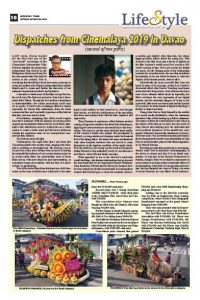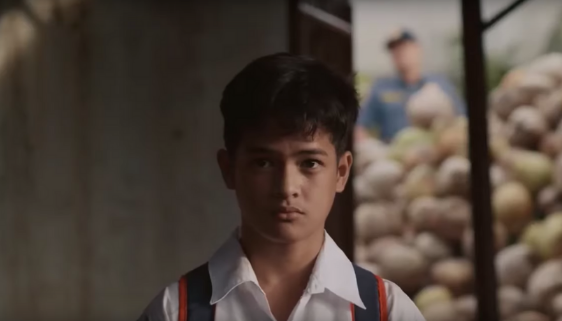
Last week, Davao hosted for the first time one of the “provincial” screenings of the Cinemalaya Independent Film Festival, arguably the pioneering independent film festival in the Philippines which paved way for the non-mainstream film festival culture in the country. This is something that should have been done many years ago to create the audience for Filipino independent films outside Manila and to create and further the discourse of our national cinema that is holistic and inclusive.
I was able to watch most of the films excep
t for two, the sci-fi Ani (The Harvest) and actor Xian Lim’s directorial debut Tabon. Though the low audience attendance is understandable—the online promotions could only do so much—I believe the screenings offered a respite especially for Davao film enthusiasts, from the usual commercial fare, and to actually experience a film festival that they just once used to hear.
Nevertheless, sustaining this effort would require innovative solutions. With the absence of a strong policy support and sustainable framework for local films, alternative film distribution must be looked into as a viable option to create a wider reach and find more audiences outside the lugubrious state of our monopolized commercial film industry.
Unfortunately, the eight films that I saw from this Cinemalaya batch were mostly weak, ranging from tolerable to middling to downright bad. The festival, even in its previous years, have always been accused of mining the miserabilist tendency of our current cinema as shown in social realist films. By miserabilist, most of these films end up with mere depiction and representation, or sometimes empty provocation, with the lack of a direct critique or questioning.
Two of the better films from this batch are child characters on the cusp of adolescence subjected to the same harsh social realities we find ourselves in. And through their stories, we find the insidiousness of the prevailing structures and systems that cultivate hate, injustice and oppression.
Thop Nazareno’s sophomore effort features another coming-of-age story similar to his debut Kiko Boksingero, applying the same tenderness and sensitivity to his storytelling. This time he sets the story amid the harsh reality of the country’s health care system. His protagonist is Edward, a young adolescent sleeping under the hospital bed of his ailing father. He shares the same predicament with other hospital watchers who are forced to cram themselves in the hapless condition of the small wards. The title itself is a clever play on the word as if tying the titular Edward to this makeshift world of convalescence and illness, where life and death converge.
What appealed to me is the director’s particular world-building—the human relationships that go beyond the functional and yet are engendered despite dehumanizing situations. Edward and his friend for instance have become errand boys for the hospital staff. It is during these errands that Edward gets to meet his romantic interest, a carefree girl slightly older than him, but whose happy-go-lucky nature draws the young boy. This element to the film is not just a devise to lighten up the film location’s sordid mood but crucial to Edward’s coming-of-age. Not to give away the details too much, but the turning point of his relationship towards his wounded muse, the one that actualizes his maturity, is the one where he learns to value the dignity of the human person, dead or alive.
Undoubtedly the most powerful film from the batch in terms of its message, Arden Rod Condez’s directorial debut John Denver Trending went home as the festival’s best picture. A lot of those who have seen it have already talked about its topicality, the film’s existence the very expression of our digital present, and the attendant dangers of living in the post-truth, fake news era where truth and the pursuit of it seems to be at the hands of digital technology’s facility to distort and alter.
Young John Denver finds himself in the middle of a social media hullaballoo when his classmate uploads a video of him beating up a fellow classmate. The nature of these de-contextualized viral videos is the subject of the film as we enter into the world of John Denver and realizing how the individual and socio-political dynamics of his small-town community ultimately impacts the attainment of justice. There are some very powerful moments particularly those that portray the mother-son relationship of John Denver and his mother, played with silent magnanimity by Meryll Soriano.
But what gives the film another layer of meaning, despite what I feel is lackluster cinematography, is the choice to situate and shot it in an island community—it was shot in the director’s hometown in Pandan, Antique. Here we see that its commentary is more extensive as it also points towards the effects of modernization, in the form of consumerism and tourism, having disrupted our ways of living, our sense of social cohesion, the very fabric of our existence.

